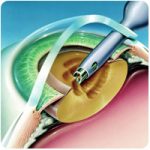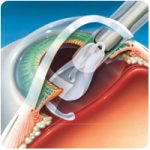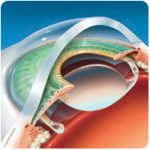Cataract Surgery
The procedure of cataract removal is executed in the operating theater in sterile conditions and lasts about 20 minutes. After cycloplegia (dilution of the
pupils), the surgery is executed in local anesthesia using a shot or eye drops. The doctor makes a small incision about 3 mm long at the edge of the cornea. Through it, he rinses out the lens of your eye previously broken by ultrasound. Then he places a flexible intraocular artificial lens into the eye.



After the cataract surgery, there is no need for hospitalization. Pretty soon after the surgery, you can go home. You must be accompanied by your attendant. The doctor will put a bandage on your operated eye. The postoperative treatment lasts a few weeks after the intervention.
It is common to notice improvement of the vision as early as the next day, but the outcome takes several weeks. You should be able to drive and come back to work within a few days after the procedure.
Nevertheless, have in mind that if you have a cataract on both eyes, your vision will be off-balance in the interval between the two treatments.
Phacoemulsification or cataract surgery can be applied with other corrective methods, such as laser intervention LASIK or PRK for the more precise correction of astigmatism (cylinder).
What You Need to Know Before the Cataract Surgery
We recommend every patient who opts for cataract surgery to be disciplined and to obey the rules and therefore quicken his recovery. Before the intervention, you need to do a few checkups:
Laboratory Analyses
You should finish with all your laboratory analyses a few days before visiting an internist. This includes biochemistry blood test done in the morning, before breakfast. The following are necessary:
- Complete blood count
- Urea
- Creatinine
- Glycemia
- Prothrombin time
Internist Examination
The examination with an echocardiogram is necessary for the medical specialist to approve this type of intervention. The results of the internist examination are valid for a month.
Swab
You should do an eye swab before the cataract surgery to confirm there are no bacteria in the eye that can cause an infection after the surgery. Five days before the scheduled surgery you should put antibiotic eye drops four times a day in both eyes.
Preparation
Cataract surgery is nowadays an outpatient procedure in local anesthesia. The patient stays for two to three hours in the clinic so he could be prepared well. The surgery itself lasts for about 20 minutes. You must talk to an anesthesiologist who is there the whole time of the cataract surgery next to the ophthalmologist. Right before the surgery we put anesthetic drops into the eye and dilate the pupil to prepare the eye for the surgery. During the intervention the patient communicates with the doctor, he hears what is going on around him, but doesn’t feel any pain. In case he feels the pain during the surgery, he should immediately report it to the doctor.
The Day of the Surgery
If the patient takes medication regularly, he should do it on the day of the surgery as well. He should not eat or drink two hours before the surgery. He should not eat anything sweet and he should avoid alcohol 24 hours before the surgery. He should bring an undershirt, pajama bottoms or tracksuit bottoms, find an attendant and transport on the day of the surgery, as well as for the follow-up exam the next day.
After the Surgery
Every patient lies for half an hour after the surgery to take a rest and then goes home. A plastic shield is placed over his operated eye. The patient sleeps with it for protection. He takes off the shield only when he puts eye drops according to the doctor’s instructions. At home he should relax and take a rest; he is allowed to eat normally and watch TV.
The day after the surgery the patient comes for his appointed follow-up examination! Usually, the patient feels mild scratching or discomfort in the eye. Also, he can report glare at the source of light, and his eye may be mildly red. All these symptoms are normal and they gradually disappear in the following few days, until the eye fully recovers.
The results of the surgery also depend on the patient’s discipline concerning the therapy prescribed.
Important!
It is critical to know the patient should NOT do the following:
- Touch or rub your eyes with the hands;
- Allow the following to enter the eye: water, soap, shampoo in the next 7 days;
- Wash the face in the next 7 days;
- Lift heavyweight and bend down;
- Swim in a lake, river, or pool in the following month;
- Be in smoke-filled rooms and crowded public transport;
- Put on makeup or use mascara in the following month;
The most important notice for all who are undergoing cataract surgery is they shouldn’t rub their eyes.